Producing for Parma ham: How to survive?
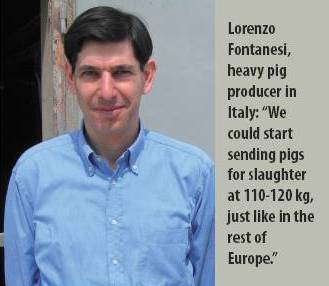
Pig production in Italy is a one-off market. Specific detailed guidelines make it a sport in itself – a sport, however, that is more and more difficult to be practised. Pig Progress visited an Italian swine farm – and learnt about the precarious situation of pig farming in Italy.
Suingrass pig farms can be found in the heart of the vast Po Plains, an area central to Italian pig production. The operation is a multi-site farrow-to-finish pig farming facility, owned by Lorenzo Fontanesi, aged 41. As is common in Italy, he keeps his pigs on-farm longer than a conventional European pig facility. His pigs are sent for slaughter at 170-180 kg for the production of traditional certified Italian hams, known as prosciutto di Parma (Parma ham – without the trotter) or prosciutto di San Daniele (San Daniele ham – with the trotter).
His breeding facilities, in Modena province, are located near the village of Novi de Modena, and are surrounded by 100 hectares of flat land where he grows corn, barley and maize, all destined for swine nutrition. A silvery shining silo tops the facility, and brand new offices flank the operation, indicating good fortunes. Fontanesi, however, is quick to deny the suggestion of prosperous times. “Not everything that shines is gold.”
Prior to this year’s edition of the Italian biannual pig show, Rassegna Suinicola in the Northern Italian city of Reggio Emilia, Fontanesi joined a protest by about 250 desperate pig farmers asking both government and retailers for fundamental changes in order to save the industry. They drew attention to the difficult times producers are in. Fontanesi did not waive the flags, but he was there, showing his silent support.
As far back as Roman times, this area in the north of Italy has been known for its outstanding ham quality. For years and years, the climate and slightly salty sea winds around the city of Parma were favourable for a sweet nutty taste to the hams. Over the centuries, the region received an image of being a gastronomic paradise with both famous Parmesan ham and cheese production. Originally only for the rich, the market slowly opened up over the last decades. As increasing amounts of people could afford to buy expensive products such as certified hams the demand rose and the pig producing industry prospered. Such was the situation when times changed roughly four years ago. A series of adverse market conditions, caused by Swine Vesicular Disease outbreak (2006), followed by a feed crisis (2007) and a financial crisis (2008), made life hard for many pig producers throughout the North of Italy, cumulating in last April’s protests.
Luca Buttazzoni, technical director for the Italian national association of pig breeders (ANAS), can understand the producers’ anger, saying: “Pig farms have been working under cost price for over four years now. So many farms are virtually owned by banks. Because of the financial crisis it is difficult to get more credit, so this means that the fate of the sector is at stake.”
Most of the anger of the producers is directed at the retail chains, who retain a large part of the retail value. Producers claim that more than half of the final retail price is taken by the ratailers. “The other half is shared between the industry and the pig producers. Since the industry is concentrated and the farmers are not, the power of the farmers is minimal,” said Buttazzoni. “Pig farmers would like to build a common front with the packers, but not all of the industry agree yet.”
Fontanesi puts the development of Parma ham production in a broader context. He explains, “The old process of producing Parma hams is now more expensive than in other countries. It takes long to grow a pig in this way. That is adverse in many ways: money-wise, time-wise and people-wise.”
Fontanesi recalls that everything was profitable until 2004. “In 2001, prices paid for 1 kg of liveweight pork was €1.50. That was well-paid, seeing that prices of production used to be €1/kg and since our pigs are sent for slaughter at 175 kg. A lot of people made debts to enlarge their establishments.”
Times changed, and the reverse was seen over the last couple of years. Prices of production rose to levels as high as €1.30, but prices paid dropped to €1-€1.20. Fontanesi adds, “This means that a lot of farmers have ended up with large debts at a time when prices for meat decreased. All their money was in the structure of the building – which is money the bank wants back. They wonder how to cover their debts? How to go on?”
This is a question Buttazzoni also hopes to answer. “If the crisis will ease, we will probably see an increase in consumption of quality products together with new awareness of the weaker points of the system. There will be a more than limited chance of production increase… and a chance to change things fundamentally, i.e. dealing with issues like pollution. In this scenario interprofessional agreements could be possible to maintain our industry.”
He continues, “If the economic crisis is going to last, then we will see a dramatic change in pig production structurally. It will lead to an expansion of integration and a progressive abandoning of quality production. Eventually this will lead to change in this industry and a buy-out by foreigners. This is what I would call a bad scenario.”
Will it lead to the disappearance of heavy pig production? Buttazzoni smiles, “Of course we will try to maintain meat production in Italy and obviously a niche market will always continue to exist. But what we will probably see is a banalisation of quality products. But disappearance? No… Nothing happens overnight in Italy.”
Fontanesi is quick to remind that supermarkets have kept prices for Parma ham high, as it is still considered a quality product. In times of an economic crisis, this means that less consumers are interested – and instead go for cheaper pork or foreign hams. He has not moved into an emergency plan yet, but admits he is trying to find out the best ideas to survive. The first option would be related to his own estate. “We could start splitting up the production process into production for two kinds of ham. We could start sending pigs for slaughter at 110-120 kg – just like in the rest of Europe. The other solution is: let’s not decrease the production for the Parma ham industry. Let’s sell about 80% abroad, let’s export it. We used to sell to the rich in Italy, now we have to find them elsewhere in Europe.”
Please check www.pigprogress.net/photo-gallery for an online tour to Suingrass and Suinicola.
Rassegna Suinicola 2009: Fewer visitors The precarious situation of Italian pig production was reflected in the number of visitors at this year’s edition of the pig production show Rassegna Suinicola, held at the SIPER fairgrounds in the city of Reggio Emilia, Italy, 16-18 April. The total number of visitors to this 50th edition was 11,827, which was a decrease of 25% in comparison to 2007, when almost 16,000 people came to visit the exposition. Just over 4% (507) of the visitors were international, among which from the Netherlands, Spain, France, Slovenia, Hungary, Denmark, Austria, Switzerland, Belgium, Croatia, Germany, Poland, China, Russia and Argentina. The total number of exhibitors was 266. |
“Prosciutto di Parma” – A tradition on its own Of all the 13 million pigs produced in Italy every year, about 70% (or 9 million) are destined for the certified Italian ham industry. This sweet high quality product is the pride and joy of the country’s industry – and heavily protected by production guidelines, both during the pig’s life and after, to ensure the quality of certified ham production. The Parma Quality Institute (Istituto Parma Qualità) plays an important role in setting these guidelines and making sure that these are abided by. Certification rules take into account nutrition, feeding programmes, breed and weight at slaughter. Ongoing checks both on-farm and in pork processing facilities have to ensure that all rules are abided by. The strictness can be told by the figures: of the 9 million pigs – having 18 million hind legs – produced for Parma hams, only 15 million legs are allowed to be sold as certified hams. Instead, they will go for sale without ‘brand’ for a lower price. Fat layers Ham fat quality is essential. After slaughter, the legs are hung for drying for nine months. In this period, called seasoning, the legs are cured in salt – fat quantity on the outside of the leg plays a vital role in this process. In case the fat layer is too small, salt will enter the meat and destroy the meat’s typical flavour, reducing the value of the hams. Qualities like fat layers can be bred on – and that is why many breeding companies have developed a special breed for Italian Parma ham production. For breeder HBI/Topigs, the Italian Fomeva 11 boar was introduced into the Italian market for Parma ham production. Dr Stefano Greatti explains, “There are a couple of things important for the Italian market. They want to see good fat covering, good FCR, no marbling and the right size. As for the marbling – this means that we do not want to have drops of fat inside the muscles. As for the size – the hind legs should not be too round. The salt has to be allowed to reach every bit of the leg.” Breeding at Suingrass Apart from meat quality, there is one more essential element in pig breeding for Parma ham production. All animals have to be from Italian descent, and bred and grown in Italy. Many producers, for that reason, participate in the breeding scheme of of the Italian Herdbook – Lorenzo Fontanesi being one of them. On-farm, Fontanesi keeps a number of boars for insemination purposes. In addition, GP and GGP sows, all Italian Large White x Italian Landrace, are being kept as well, see Figure 2. An Italian Duroc (known for fat meat quality production) is taken as terminal sire. Marking During pork production, even closely after birth, the animals need to be specifically marked, to indicate that they have been born in Italy. A special combination of letters and numbers indicates in what province the pig was born (Modena), on what farm (Suingrass) and in what month (B = March). This is to prevent pigs from outside the designated areas – or animals which are too young – ending up being slaughtered for Parma ham production. In addition, piglets have to be castrated and vaccinated for Mycoplasma and Aujeszky’s Disease – although the farm is Aujeszky-free. Slaughter weight The pigs have to be at least 9 months and 1 day old before being sent for slaughter – and officially weigh between 144-176 kg when they are transported to the macello – Italian for slaughterhouse. Fontanesi ships the pigs to the slaughterhouse at about 170 to 180 kg. In order to reach this weight, he keeps his pigs in-house until they have been there almost ten months. They arrive from the breeding facilities at about 35 days of age, with all pigs then receiving a liquid diet. They receive a mixture of barley, wheat, maize and this is all mixed with whey, which is obtained from a nearby Parmesan cheese facility. |
Join 18,000+ subscribers
Subscribe to our newsletter to stay updated about all the need-to-know content in the pigsector, three times a week. Beheer
Beheer

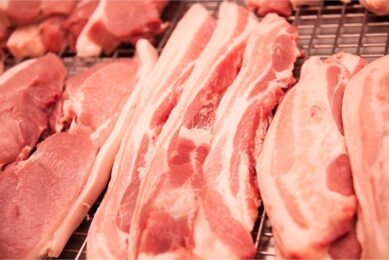
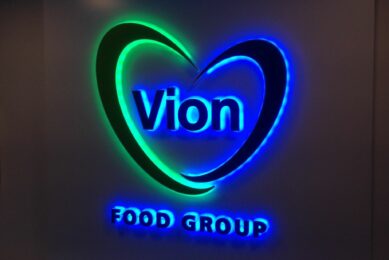
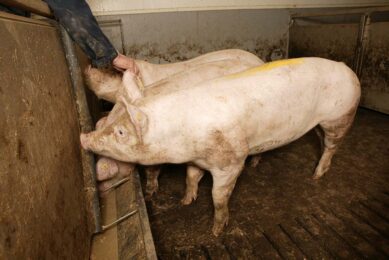
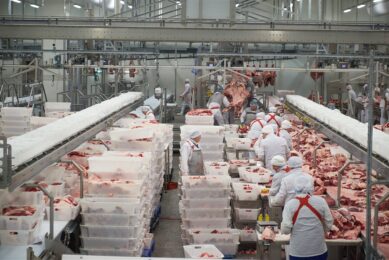





 WP Admin
WP Admin  Bewerk bericht
Bewerk bericht